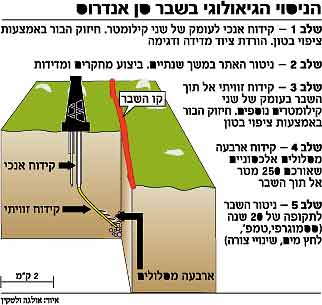Geology/ The first experiment of its kind will be conducted in Parkfield, California, which is considered the "earthquake capital" of the world
Yuval Dror

The geological experiment in the San Andrews Fault-Illustration American geologists are supposed to finish drilling a two-kilometer-deep pit in the coming days, near the city of Parkfield in California. Upon completion of the drilling, the scientists will check if it is possible to drill a four kilometer deeper hole, into which they will insert equipment that will record closely, for the first time, the occurrence of an earthquake. The scientists hope that the success of the experiment will provide important information that may give them the means to build an earthquake warning system.
Parkfield is considered the "earthquake capital" of the world. The reason for the title stems from the series of earthquakes that have hit the city in the last two centuries. The first recorded earthquake occurred in 1857. Since then the city has experienced additional earthquakes in 1934
1922, 1901, 1881 and 1966 or on average, every 21 years. Studies in the area have raised a hypothesis, according to which these are "typical earthquakes" that occur once every few years, as part of the constant tectonic activity in the San-Andros fault. The activity scares the residents of Los Angeles, who fear the strongest earthquake of all. As a result, the area became the largest earthquake monitoring laboratory and the first place in the world where, 20 years ago, underground monitoring equipment was installed.
The Geological Survey Agency (USGS) has been operating in the US since 1879. Recently, the agency decided to conduct a first-of-its-kind experiment known as "Safod" in which sensitive devices for monitoring earthquakes will be implanted as close as possible to the source of the noise. As part of the experiment, a two-kilometer-deep pit is currently being dug near Parkfield.
Upon completion of the excavation of the first pit, the scientists will chain equipment into it, which will provide them with an image of the state of the fracture and help them decide where to dig the second - deeper pit. In addition, the scientists will have to wait until Congress approves an additional budget for the digging of the second pit.
Upon completion of the digging of the second pit, seismographic equipment will be lowered to the bottom, which will record the underground activity that produces the earthquakes in the area, as well as equipment that will monitor changes in water pressure. This is due to the hypothesis that these changes indicate the coming of earthquakes. Until now, earthquake researchers have used equipment that was placed on the surface of the ground or buried several meters into it.
Dr. Mark Zodak, the chief geologist overseeing the project, told the BBC that upon completion of the project, the geologists will be able to operate the first underground observatory of its kind in the world. "It's like using a stethoscope and listening carefully to what's going on," he said. According to him, the project aims to try and locate the seismic forces that operate before, during and at the end of an earthquake. Locating the forces may help scientists warn the public before the noise.
"We have not found any reliable way to provide a short-term warning before the occurrence of earthquakes," admits the geologist Stefan Hickman who is involved in the project. "There have been more failures than successes when it comes to predicting earthquakes." According to him, today geologists can say with a weak level of certainty that there is a danger that an earthquake will occur along a certain fault line in the world in the next 30 years.
According to estimates, the next serial earthquake in Parkfield was supposed to occur between the years 1998-1993, until yesterday it did not occur. The geologists, surprised by the lack of accuracy, request to go ahead and place their monitoring equipment in the underground observatory. This is not a simple job: the hard granite soil allows the sophisticated equipment to dig only to a depth of 5-4 meters per hour. In the meantime, geologists hope that the next earthquake will hold back.
